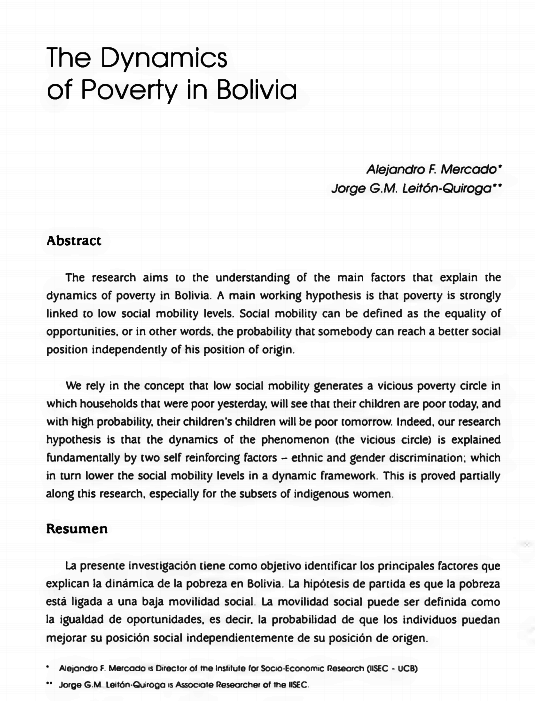The Dynamics of Poverty in Bolivia
DOI:
https://doi.org/10.35319/lajed.200911169Keywords:
poverty, Social Mobility, discriminationAbstract
The research aims to the understanding of the main factors that explain the dynamics of poverty in Bolivia. A main working hypothesis is that poverty is strongly linked to low social mobility levels. Social mobility can be defined as the equality of opportunities, or in other words, the probability that somebody can reach a better social position independently of his position of origin.
We rely in the concept that low social mobility generates a vicious poverty circle in which households that were poor yesterday, will see that their children are poor today, and with high probability, their children's children will be poor tomorrow. Indeed, our research hypothesis is that the dynamics of the phenomenon (the vicious circle) is explained fundamentally by two self reinforcing factors - ethnic and gender discrimination; which in turn lower the social mobility levels in a dynamic framework. This is proved partially along this research, especially for the subsets of indigenous women.
Downloads
References
Altonji. G. J. and R. M. Blank 1999. "Race and Gender in the Labor Market".En O. Ashenfelter y D. Card (eds.) Handbook of Labor Economics 3c: 3143-3259.
Andersen, Lykke. 2003. "Baja movilidad social en Bolivia". Revista Latinoamericana de Desarrollo Económico. Septiembre. Universidad Católica Boliviana. La Paz
Dahan, M. and A. Gaviria. 2000. "Sibling Correlations and Social Mobility in Latin America" Interamerican Development Bank. Office of the Chief Economist. Draft. Marzo.
Fields, G. S. 1996 "Accounting for Differences in Income Inequality". School of Industrial and Labor Relations. Cornell University. Draft. Enero.
Instituto Nacional de Estadística. Encuestas de Hogares 1993. 2003, 2004. La Paz, Bolivia.
Juhn, Chinhui. Kevin M. Murphy and Brooks Pierce. 1993. "Wage Inequality and the Rise in Returns to Skill". The Journal of Political Economy. Vol. 101, No. 3. June. Pages 410-442.
Klasen, Stephany, Melanie Grosse, Rainer Thiele. Jann Lay, Julius Spatz and Manfred Wiebelt. 2002. Operationalizing Pro-Poor Growth. Country Case Study: Bolivia. KfW Entwicklungsbank (KfW Development Bank).
Leitón, Jorge G.M. 2005. “¿Existe una tendencia hacia la feminización de la pobreza?" Revista Latinoamericana de Desarrollo Económico. Abril. Universidad Católica Boliviana.La Paz.
Mercado, Alejandro F. 1992. "Elementos para el diseño de políticas en el ámbito laboral". Fundación Milenio. Mimeo. La Paz, Bolivia.
Mercado. Alejandro F., Lykke Andersen, Osvaldo Nina and Mauricio Medinacelli. 2002. "Movilidad social: clave para el desarrollo". Programa de Investigación Estratégica en Bolivia (PIEB) - Instituto de Investigaciones Socio Económicas (IISEC) Universidad Católica Boliviana. La Paz.
Mercado, Alejandro F., Jorge G.M. Leitón and Fernando Ríos. 2004 “Segmentación en el mercado matrimonial". Revista Latinoamericana de Desarrollo Económico. Octubre. Universidad Católica Boliviana. La Paz.
Mercado, Alejandro F., Jorge G. M. Leitón and Marcelo F. Chacón. 2005. "El crecimiento económico en Bolivia (1952-2003) ". Revista Latinoamericana de Desarrollo Económico. Edición Especial, Julio. Universidad Católica Boliviana. La Paz.
Mood, A.M., F.A. Graybill and D.C. Boes. 1974. Introduction to the Theory of Statistics. Third Edition. McGraw-Hill.
Sen, Amartya. 1999. Development as Freedom. Oxford University Press.






